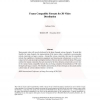Free Online Productivity Tools
i2Speak
i2Symbol
i2OCR
iTex2Img
iWeb2Print
iWeb2Shot
i2Type
iPdf2Split
iPdf2Merge
i2Bopomofo
i2Arabic
i2Style
i2Image
i2PDF
iLatex2Rtf
Sci2ools
ICIP
2010
IEEE
2010
IEEE
Frame compatible formats for 3D video distribution
Stereoscopic video will soon be delivered to the home through various channels. To make this feasible for some channels, the representation of the stereo video is modified to accommodate certain constraints on legacy systems. Among the various constraints that must be considered include the capabilities of production equipment and transmission infrastructure, as well as existing receivers and uncompressed digital interfaces between devices within the home. This paper outlines the typical constraints that are encountered in these domains and provides an overview of the various frame-compatible formats that are being considered for distribution of 3D video through such legacy systems. The benefits and drawbacks of these formats are discussed and the current status in various industry forums is reviewed. IEEE International Conference on Image Processing (ICIP) 2010 This work may not be copied or reproduced in whole or in part for any commercial purpose. Permission to copy in whole or in ...
Electric Research Laboratories | ICIP 2010 | Image Processing | Legacy Systems | Mitsubishi Electric Research |
| Added | 03 Mar 2011 |
| Updated | 03 Mar 2011 |
| Type | Journal |
| Year | 2010 |
| Where | ICIP |
| Authors | Anthony Vetro |
Comments (0)

